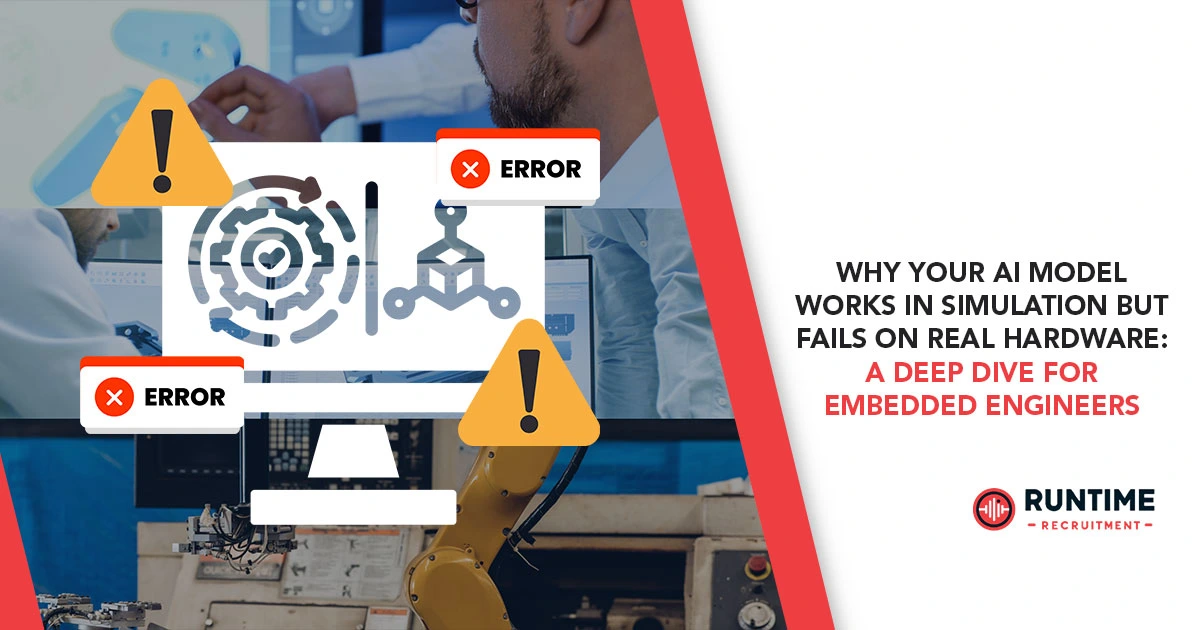As embedded engineers, we live in a world where the lines between hardware and software are increasingly blurred. The rise of Artificial Intelligence, particularly at the edge, has presented both unprecedented opportunities and vexing challenges. We’ve all been there: painstakingly training an AI model, seeing it achieve stellar performance in a simulated environment, only to watch it falter, or outright fail, when deployed on the target embedded hardware. This isn’t a rare anomaly; it’s a common, often frustrating, rite of passage in edge AI development.
This article delves deep into the multifaceted reasons behind this discrepancy, equipping you with the knowledge to bridge the simulation-to-reality gap and ensure your AI models thrive in the wild.
The Allure and Limitations of Simulation
Simulations are invaluable. They offer a controlled, reproducible environment for rapid iteration, extensive testing, and performance benchmarking without the costs and complexities of physical hardware. For AI model development, simulators provide:
- Abundant Data: The ability to generate vast quantities of synthetic data, often with perfect labels, for training and validation. This is particularly useful for scenarios that are difficult or dangerous to replicate in the real world (e.g., autonomous driving, industrial accidents).
- Idealized Conditions: Simulators typically operate under ideal conditions, free from real-world noise, sensor imperfections, timing variations, and environmental interferences.
- Debugging Ease: Simulators often come with robust debugging tools, allowing engineers to introspect model behavior, visualize activations, and pinpoint errors at a granular level.
- Resource Unconstrained: In a simulation, you usually aren’t limited by memory, processing power, or power consumption. This allows for experimentation with larger, more complex models than might be feasible on the target hardware.
However, it’s precisely these advantages that sow the seeds of future failure. The “perfect” world of simulation rarely, if ever, mirrors the chaotic and resource-constrained reality of embedded systems.
The Harsh Realities of Embedded Hardware
Deploying AI on embedded hardware introduces a slew of constraints and complexities that are often abstracted away or simply non-existent in simulation.
1. Resource Limitations: The Elephant in the Room
Edge devices are inherently resource-constrained. Unlike cloud servers with vast computational power, memory, and energy, embedded systems typically operate with:
- Limited Compute Power: Forget about racks of GPUs. Edge devices rely on microcontrollers (MCUs), low-power CPUs, or specialized AI accelerators (NPUs, DSPs, tiny FPGAs). These components have significantly less floating-point performance and parallel processing capabilities. Your model’s complexity, inference speed, and overall throughput will be directly impacted.
- Memory Constraints: RAM and flash memory on embedded devices are measured in kilobytes or megabytes, not gigabytes or terabytes. This severely limits the size of your AI model, its weights, activations, and any intermediate data. Techniques like quantization (reducing numerical precision, e.g., from float32 to int8) and pruning (removing unnecessary connections in neural networks) become not just optimizations, but necessities.
- Power Budgets: Many embedded systems are battery-powered, demanding ultra-low power consumption. Running complex AI models continuously can quickly drain batteries. This necessitates careful optimization of algorithms, efficient use of hardware accelerators, and potentially even duty-cycling or event-driven processing.
- Thermal Management: Continuous execution of AI models on small form-factor devices can lead to overheating, which can degrade performance, shorten device lifespan, or even cause system shutdowns.
2. The Data Mismatch: Real-World Imperfections
The biggest disconnect often lies in the data.
- Sensor Noise and Variability: Real-world sensors are imperfect. They introduce noise, drift, calibration errors, and varying environmental conditions (lighting, temperature, humidity, vibrations). A model trained on clean, idealized simulated data will struggle to generalize to these real-world imperfections.
- Domain Shift: The distribution of data encountered in the real world can subtly, or sometimes drastically, differ from the training data generated in simulation. This “domain shift” can cause a perfectly accurate simulated model to perform poorly when faced with unseen, yet realistic, scenarios. For instance, a vision model trained on pristine images might fail with blurry, occluded, or poorly lit real-world inputs.
- Labeling Discrepancies: While simulated data can have perfect labels, real-world data collection and labeling can introduce errors, inconsistencies, or ambiguities that the model hasn’t been trained to handle.
- Data Skew and Imbalance: Real-world data often exhibits imbalances, where certain classes or scenarios are far less frequent than others. If the simulation doesn’t accurately reflect this imbalance, the model might be biased towards the overrepresented classes in the real world.
3. Software and Hardware Interactions: The Unseen Complexities
Beyond the model itself, the interplay between your AI model, the embedded software stack, and the hardware platform introduces significant hurdles.
- Toolchain and Framework Compatibility: The AI framework (TensorFlow Lite, PyTorch Mobile, ONNX Runtime) and the chosen hardware accelerator (e.g., specific NPUs, DSPs, or even custom ASICs) need to have compatible toolchains. Discrepancies in compiler optimizations, floating-point arithmetic implementations, or driver versions can lead to subtle yet critical deviations in model execution.
- Operating System and Scheduler Effects: If your embedded system uses a Real-Time Operating System (RTOS), the scheduling of AI inference tasks relative to other critical system functions can introduce unpredictable latency or even task starvation. Deterministic behavior is paramount in many embedded applications, and an RTOS can impact this.
- Memory Access Patterns and Caching: The way your AI model accesses memory can significantly impact performance on hardware. Cache misses, inefficient memory transfers, and contention for shared memory resources can introduce bottlenecks not apparent in simulation.
- Quantization Effects: While quantization is essential for efficiency, it’s not a magic bullet. Reducing precision can introduce quantization errors, especially if not done carefully with post-training quantization aware training (QAT) or during training. These errors can accumulate and degrade model accuracy.
- Hardware Accelerators and Their Quirks: Each AI accelerator has its own architecture, instruction set, and programming model. Optimizing your model for a specific accelerator often requires specialized knowledge and tools, and what works perfectly on one accelerator might be inefficient or incorrect on another. Bugs in accelerator drivers or firmware can also manifest as model failures.
4. Real-Time Requirements and Latency: Every Millisecond Counts
Many embedded AI applications, like autonomous vehicles, robotics, or industrial control, demand real-time responses.
- Inference Latency: The time it takes for your model to process an input and produce an output must meet strict deadlines. Simulation often doesn’t accurately reflect the true inference latency on resource-constrained hardware, which can be affected by CPU cycles, memory bandwidth, and accelerator efficiency.
- Throughput: The number of inferences your system can perform per second is crucial. Bottlenecks in data acquisition, pre-processing, or post-processing can significantly limit the effective throughput, even if the core inference engine is fast.
5. Debugging in the Embedded World: A Different Beast
Debugging an AI model that fails on hardware is considerably more challenging than in simulation.
- Limited Observability: You often lack the rich debugging tools and introspection capabilities available in a simulated environment. Getting detailed logs, inspecting intermediate tensor values, or stepping through individual operations on hardware can be difficult or impossible.
- Remote Debugging Challenges: Connecting to and debugging a remote, often deployed, embedded device presents its own set of network, security, and access challenges.
- Intermittent Failures: Real-world issues can be intermittent, sensitive to environmental factors, or dependent on specific data patterns, making them notoriously difficult to reproduce and diagnose.
- Silent Data Corruptions (SDCs): As highlighted by Meta’s experience with AI hardware reliability, silent data corruptions can occur due to hardware defects, leading to incorrect computations without explicit error messages. These are particularly insidious and require advanced detection mechanisms.
Bridging the Gap: Strategies for Success
So, how do embedded engineers navigate this treacherous terrain?
- Start with the Hardware: Before even training your model, deeply understand the target hardware’s capabilities and limitations. What are the memory constraints? What AI accelerators are available? What are the power budgets? This informs your model architecture choices from the outset.
- Realistic Data is King: Prioritize collecting and using real-world data from the target environment for training and validation. If synthetic data is necessary, ensure it closely mimics the noise, imperfections, and distributions found in the real world. Consider data augmentation techniques to increase the robustness of your model to real-world variations.
- Hardware-Aware Model Design and Optimization:
- Lightweight Architectures: Opt for naturally lightweight models like MobileNets, EfficientNets, or custom architectures designed for edge devices.
- Quantization and Pruning: Systematically apply quantization (post-training or quantization-aware training) and pruning techniques to reduce model size and computational demands. Understand the accuracy-performance trade-offs.
- Knowledge Distillation: Train a larger, more powerful “teacher” model and then distil its knowledge into a smaller “student” model suitable for edge deployment.
- Custom Operators: If specific operations are performance bottlenecks, consider implementing custom, highly optimized operators for your hardware.
- Leverage Edge AI Frameworks and Tools: Utilize frameworks specifically designed for edge deployment, such as TensorFlow Lite for Microcontrollers (TFLite Micro), PyTorch Mobile, or ONNX Runtime. These frameworks often provide optimized kernels and deployment tools.
- Robust Testing and Validation on Target Hardware:
- Representative Test Sets: Test your model on a diverse and representative dataset collected directly from the target hardware in its intended operating environment.
- Edge-to-Cloud Mismatch Analysis: Implement mechanisms to compare the outputs of your model on the edge device with a “golden” cloud-based reference model. This can help identify subtle discrepancies.
- Profiling and Benchmarking: Extensively profile your model’s performance on the hardware, measuring inference time, memory usage, and power consumption.
- Adversarial Testing: Consider adversarial attacks or stress testing to evaluate model robustness in challenging real-world scenarios.
- Comprehensive Debugging Strategies:
- On-Device Logging: Implement detailed logging on the embedded device to capture inputs, outputs, and intermediate states of your model.
- Hardware-in-the-Loop (HIL) Testing: Integrate your physical hardware with simulation environments to create a more realistic testing setup.
- Explainable AI (XAI) Techniques: Even on embedded systems, try to incorporate XAI methods (e.g., saliency maps) to understand why your model is making certain predictions, which can help pinpoint issues.
- Modular Debugging: Break down the AI system into smaller, testable components (data preprocessing, inference engine, post-processing) to isolate issues.
The journey from a working simulation to a robust, real-world edge AI deployment is fraught with challenges. However, by understanding the fundamental differences between these environments and proactively addressing them with hardware-aware design, realistic data, and comprehensive testing, embedded engineers can successfully bring intelligence to the edge.
Is your AI model struggling to make the leap from simulation to hardware? The right talent can make all the difference. At RunTime Recruitment, we specialize in connecting innovative companies with top-tier embedded engineers who possess the deep expertise in AI, hardware optimization, and real-time systems needed to overcome these complex challenges. Our team understands the nuances of edge AI development, because we’re engineers ourselves.
Don’t let your groundbreaking AI project stall at the hardware integration phase.
Connect with RunTime Recruitment today to find the expert talent that will turn your simulation success into real-world triumph.









